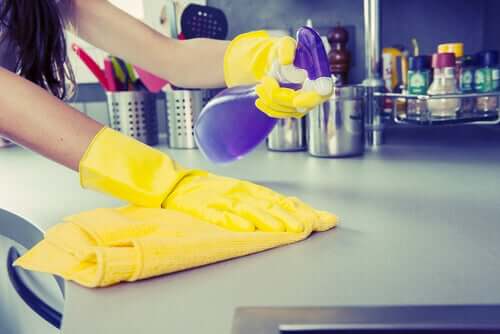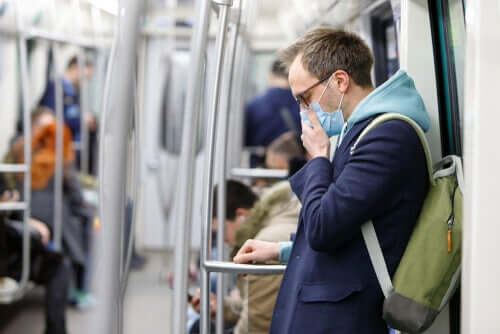How Long Does the Coronavirus Survive on Surfaces?


Written and verified by the doctor Leonardo Biolatto
Scientists have worked hard to fully understand SARS-CoV-2, a virus also known as COVID-19, or simply coronavirus. However, many aspects are still uncertain. Among them, we still don’t know exactly how long the coronavirus can survive on surfaces. This issue is not a minor one, as it has a direct bearing on the spread of the disease.
However, we need to clarify one thing first. According to the available evidence, touching an object where the virus is doesn’t automatically infect you, but it does increase one’s risk of contracting it. This is because, if a person touches a surface with a coronavirus, then it can remain on his or her hand. If that hand then touches the person’s face, and the virus comes into contact with the eyes, nose, or mouth, then it will enter the body. This is why it’s important to disinfect surfaces and wash your hands often.
How long does coronavirus survive on surfaces?
So, how long does the coronavirus survive on surfaces?
Unfortunately, there are still no fully verified data regarding this subject. In fact, the World Health Organization (WHO) has stated that “it isn’t known how long SARS-CoV-2 survives” on objects.
However, based on the behavior of other viruses, experts believe that the coronavirus can remain for a relatively long time on different surfaces. This also depends on environmental conditions, such as temperature and humidity.
Many viruses remain between a few hours and several days, depending on the type of surface they are on. The coronavirus doesn’t seem to be an exception to this, and so reasonable precautions must be taken to avoid infection.

Read on: Washing Your Hands: Coronavirus’s Biggest Enemy
Scientific studies on the subject
Research published in the Journal of Hospital Infection analyzed available information on the behavior of other coronaviruses such as SARS and MERS. Based on this, they pointed out that SARS-CoV-2 could remain between a few hours and several days, depending on the type of surface and environmental conditions.
According to that research, on surfaces such as metal, glass, and plastic, the virus could remain for four to five days. However, under favorable temperature and humidity conditions, it could stay for up to nine days.
Another study, published in The New England Journal of Medicine, and conducted by scientists at a U.S. federal laboratory, indicated that the duration of the coronavirus on surfaces varies from four hours on copper to three days on plastic and stainless steel. On cardboard, it lasts up to one day.
Duration in the air

A recent, and relatively worrying, development appeared in a pre-published report. This means that it’s a kind of draft, which the writers could later be adjust or correct. In short, it warns that they are still processing the information. The data in the draft suggests that the virus may remain in the air for up to three hours after it is aerosolized. In medicine, an infectious organism is said to be in aerosol form when particles, or tiny drops of liquid containing the virus, are suspended in the air.
The New England Journal of Medicine study cited above also mentions that information. It confirms that they detected the virus in the air three hours after it was aerosolized.
Find out more: Is it Possible to Be Reinfected by Coronavirus?
The good news about coronaviruses on surfaces
Against this very invasive backdrop, the good news is that you can eliminate the virus very easily with simple cleaning measures. It’s advisable to clean common surfaces frequently with alcohol or a disinfectant containing alcohol. A dilution of two tablespoons of bleach or chlorine in half a liter of water is also useful.
It’s advisable to carry out this cleaning exercise every two or three hours in public places or workplaces. It’s also important to avoid touching surfaces or objects of frequent contact in public places, such as railings, elevator buttons or doorknobs. You can protect your hands with a tissue.
The most important recommendation is to wash your hands often. Also, avoid running them over your face. It’s also very important that if someone is going to sneeze or cough, then they cover their mouth and nose with a handkerchief or elbow.
In the house, it’s best to do the daily cleaning. If those who live there enter and leave frequently, then it’s best to disinfect knobs, switches and common areas frequently. You should touch items purchased with a paper towel and then disinfect them. In these cases, taking every precaution is the best thing we can do.
All cited sources were thoroughly reviewed by our team to ensure their quality, reliability, currency, and validity. The bibliography of this article was considered reliable and of academic or scientific accuracy.
- Phin, N. F. Requerimientos para uso de equipos de protección personal (EPP) para el nuevo coronavirus (2019-nCoV) en establecimientos de salud.
- Agosto, Arianna, and Paolo Giudici. “A Poisson autoregressive model to understand COVID-19 contagion dynamics.” Available at SSRN 3551626 (2020).
- Kampf, Günter, et al. “Persistence of coronaviruses on inanimate surfaces and its inactivation with biocidal agents.” Journal of Hospital Infection (2020).
- van Doremalen, Neeltje, et al. “Aerosol and surface stability of HCoV-19 (SARS-CoV-2) compared to SARS-CoV-1.” medRxiv (2020).
This text is provided for informational purposes only and does not replace consultation with a professional. If in doubt, consult your specialist.








